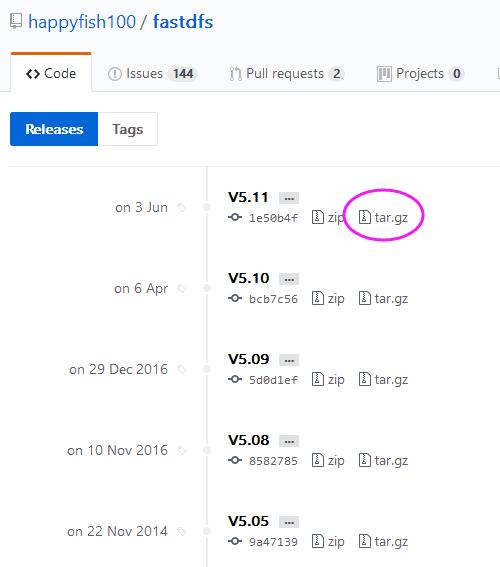使用FastDFS搭建图片服务器(单实例)
1、背景描述
之前公司的图片服务器已经不能胜任了(直接使用tomcat),需要重新搭建图片服务器,这两天研究了下FastDFS,感觉挺好用记录下来以供日后参考。
FastDFS官方介绍
FastDFS是一款类Google FS的开源分布式文件系统,它用纯C语言实现,支持Linux、FreeBSD、AIX等UNIX系统。它只能通过 专有API对文件进行存取访问,不支持POSIX接口方式,不能mount使用。准确地讲,Google FS以及FastDFS、mogileFS、 HDFS、TFS等类Google FS都不是系统级的分布式文件系统,而是应用级的分布式文件存储服务。
1、FastDFS架构图
图1:FastDFS架构图
1)Tracker cluster中各个tracker server相互独立,不进行相互通信。
2)Storage cluster中各个storage组(Volume1,Volume2...)相互独立,不进行相互通信,也就是说各个组之间保存的数据是不相同的。但是各个组中的storage server之间是属于互相备份的关系,也就是说storage server之间保存相同的数据。
3)每个storage server会启动一个单独的线程主动向Tracker cluster中每个tracker server报告其状态信息,包括磁盘使用情况,文件同步情况及文件上传下载次数统计等信息。
2、文件上传和下载的时序图
图2:文件上传时序图
1)Client通过Tracker server将文件上传到Storage server。
2)Tracker server向Client返回一台可用的Storage server的IP地址和端口号。
3)Client直接通过Tracker server返回的IP地址和端口与其中一台Storage server建立连接并进行文件上传。
4)上传完成,Storage server返回Client一个文件ID,文件上传结束。
图3:文件下载时序图
1)Client通过Tracker server下载指定Storage组中某个Storage server上的某个文件(文件名包括Storage组名称)。
2)Tracker server向Client返回一台可用的Storage server的IP地址和端口号。
3)Client直接通过Tracker server返回的IP地址和端口与其中一台Storage server建立连接并进行文件下载。
解释一下:
1. fastDFS是按照Group的形式对file进行分组存储的,这里的group1你可以理解成C盘,group2理解成D盘,所有的数据都是在Group来划分的。
2. 为了提高读取性能和热备份,我们把group1放到了两台机器上,大概可能觉得有点浪费,对吧,事实就是这样。
3. 为了提高扩展性,因为单机是有存储上限的,这时候你可以再新建一个group2,也就是D盘,放到另外机器上,这样你就扩容了,对吧。
4. trackerServer主要用来保存group和storage的一些状态信息,主要和client端进行交互,返回正确的storeage server地址,这个和hadoop的
namenode其实是同一个角色的。
5. 这里要注意的一个地方就是,client端在存储file的时候,需要告诉trackerserver,你需要存储到哪一个group中,比如group1还是group2?
2. 下载fast源码包:https://github.com/happyfish100/fastdfs/releases

3. wget之后,先把libfastcommon给安装一下
tar -xzvf V1.0.36 cd libfastcommon-1.0.36 ./make.sh && ./make.sh install
再把fastdfs安装一下。
tar -xzvf V5.11 cd fastdfs-5.11 ./make.sh &&./make.sh install
这样的话,我们的fast就算安装好了,因为是默认安装,所以配置文件是在 /etc/fdfs目录下,启动服务在/etc/init.d下。
[root@localhost ~]# cd /etc/fdfs [root@localhost fdfs]# ls client.conf client.conf.sample storage.conf.sample storage_ids.conf.sample tracker.conf.sample [root@localhost fdfs]# cd /etc/init.d [root@localhost init.d]# ls fdfs_storaged fdfs_trackerd functions netconsole network README [root@localhost init.d]#
然后再把两个storage.conf.sample 和 tracker.conf.sample中copy出我们需要配置的文件。
[root@localhost fdfs]# cp storage.conf.sample storage.conf
[root@localhost fdfs]# cp tracker.conf.sample tracker.conf
[root@localhost fdfs]# ls
client.conf client.conf.sample storage.conf storage.conf.sample storage_ids.conf.sample tracker.conf tracker.conf.sample
[root@localhost fdfs]#
4. tracker.conf 配置
这个配置文件,主要是配置里面的base_path。
# the base path to store data and log files
base_path=/usr/fast/fastdfs-5.11/data/tracker
指定完路径之后,我们创建一个data文件夹和tracker文件夹。
5. storage.conf 配置
这个配置文件,我们主要配置三样东西。
1. 本storage服务器的groupname,大家看过架构图应该也明白了,对吧。
2. 为了提高磁盘读写,可以指定本groupname的file存储在哪些磁盘上。
3. 指定和哪一台trackerserver进行交互。
# the name of the group this storage server belongs to # # comment or remove this item for fetching from tracker server, # in this case, use_storage_id must set to true in tracker.conf, # and storage_ids.conf must be configed correctly. group_name=group1 # the base path to store data and log files base_path=/usr/fast/fastdfs-5.11/data/storage # path(disk or mount point) count, default value is 1 store_path_count=1 # store_path#, based 0, if store_path0 not exists, it's value is base_path # the paths must be exist store_path0=/usr/fast/fastdfs-5.11/data/storage/0 #store_path1=/home/yuqing/fastdfs2 # tracker_server can ocur more than once, and tracker_server format is # "host:port", host can be hostname or ip address tracker_server=192.168.23.152:22122
然后在data目录下创建storage和0文件夹
6.启动 FastDFS,可以看到22122的端口已经启动了,说明搭建成功
[root@localhost ~]# /etc/init.d/fdfs_trackerd start Starting fdfs_trackerd (via systemctl): [ OK ] [root@localhost ~]# /etc/init.d/fdfs_storaged start Starting fdfs_storaged (via systemctl): [ OK ] [root@localhost 0]# netstat -tlnp Active Internet connections (only servers) Proto Recv-Q Send-Q Local Address Foreign Address State PID/Program name tcp 0 0 0.0.0.0:22122 0.0.0.0:* LISTEN 4346/fdfs_trackerd tcp 0 0 192.168.122.1:53 0.0.0.0:* LISTEN 1786/dnsmasq tcp 0 0 0.0.0.0:22 0.0.0.0:* LISTEN 1129/sshd tcp 0 0 127.0.0.1:631 0.0.0.0:* LISTEN 1128/cupsd tcp 0 0 0.0.0.0:23000 0.0.0.0:* LISTEN 4171/fdfs_storaged tcp 0 0 127.0.0.1:25 0.0.0.0:* LISTEN 1556/master tcp6 0 0 :::22 :::* LISTEN 1129/sshd tcp6 0 0 ::1:631 :::* LISTEN 1128/cupsd tcp6 0 0 ::1:25 :::* LISTEN 1556/master [root@localhost 0]#
參考: https://www.2cto.com/kf/201708/669886.html
https://blog.csdn.net/u010098331/article/details/51646921
https://www.cnblogs.com/huangxincheng/p/7928345.html
https://www.cnblogs.com/tc520/p/6822412.html



